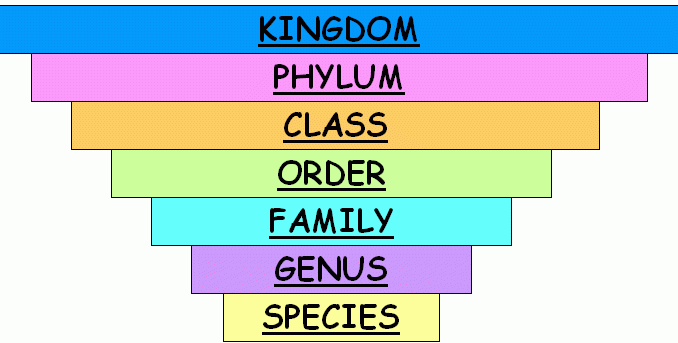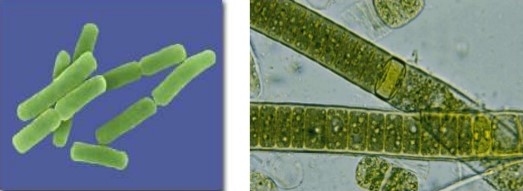
- The scientific ordering or systematic arrangement of living organisms in a hierarchical series of groups on the basis of their relationships (morphological, evolutionary and other characteristics) is called biological classification.
- The system of assigning a scientific name consisting of two components (Genus and Species) to an organism is called binomial system of nomenclature. The rules for writing a scientific name of an organism are:
- The scientific name consists of two components (first genus and second species).
- Genus always starts with a capital letter and species with a small letter.
- Both genus and species should be italicized (in printed form) or separately underlined in hand written form.
- Examples :- Rana tigrina (Frog), Pisum sativum (Garden pea).
- The branch of biological science which deals with the identification, nomenclature and classification of living organisms is called Taxonomy.
- Carolous Linnaeus (1707-1778 AD), a Swedish naturalist, developed the binomial system of nomenclature and introduced the two kingdom system of classification for the first time. Hence, he is regarded as the Father of Taxonomy.
Significance or advantages of biological classification:
- It makes the study of organisms convenient.
- It helps to study many organisms together and reveal their inter-relationship.
- It facilitates the identification of organisms.
- It reveals evolutionary trends by showing gradually increasing complexity of structure in various groups of organisms.
Two kingdom classification system:
- It is the oldest system of classification.
- It was suggested by Carolous Linnaeus in 1758.
- The entire living world was divided into two kingdoms:
- Plantae
- Animalia
- This was reasonable in his time, because the familiar plants and animals looked clearly different.
Shortcomings of two-kingdom system:
- The position of certain organisms like slime molds and Euglena (showing dual characteristics of animal and plant) in the living world was uncertain.
- It has not dealt upon the status of microorganisms in the living world like Viruses and Bacteria because they were not properly known and studied by that time.
- Fungi lack chlorophyll and are saprophytic unlike typical plants but were kept in the kingdom plantae.
Five-kingdom system of classification:
- Robert H. Whittaker, an American ecologist proposed the five kingdom classification system in 1969.
- The entire living world was divided into five kingdoms:
- Monera
- Protista
- Mycota (Fungi)
- Plantae
- Animalia
- He has based his 5-kingdom classification of living organisms on the following factors:
- Structure of cells (either Prokaryotic or Eukaryotic).
- Complexity of cells (either unicellular or multicellular).
- Mode of nutrition (either autotrophic or heterotrophic).
- Phylogenetic relationships (evolutionary history of organisms).
Monera:
- They are undifferentiated prokaryotic organisms.
- They are minute, unicellular and microscopic.
- They are ubiquitous in occurrence (they occur anywhere and everywhere).
- They reproduce asexually by binary fission and sexually by conjugation.
- They are either autotrophic or parasitic in nutrition.
- Examples :- Archaebacteria (ancient bacteria), Eubacteria (true bacteria), Cyanobacateria (blue-green algae).

Protista:
- It includes all unicellular eukaryotic organisms.
- Most of them are aquatic and inhabit the surface of water bodies as
- Cilia, flagella and pseudopodia are the locomotary organs.
- They may either be photosynthetic like Euglena, holozoic like Amoeba and parasitic like
- Binary fission is the most common method of multiplication.
- Examples :- Protistan algae (Euglena-like flagellates), water molds and slime molds, Protozoans etc.

Mycota or Fungi:
- They are eukaryotic organisms.
- They may be unicellular (Yeast, Candida) or multicellular (Mushrooms).
- They lack chlorophyll and are unable to prepare their own food by photosynthesis. They are found in humus rich soil.
- They are either parasitic or saprophytic in nutrition.
- The vegetative body in multicellular fungi is made up of thin, soft and branched structure called hypha.
- They reproduce by budding, spores and sexual methods.
- The reserved food material is glycogen.
- Cell wall is composed of chitin.
- Examples :- Yeasts, Molds, Mushrooms, Toadstools, Puffballs etc.

Plantae:
- They are eukaryotic living organisms.
- They are either unicellular (Spirogyra, Fucus) or multicellular (Moss, Pine, Apple).
- They consist of chlorophyll and are green in color.
- They are autotrophic and the reserved food material is starch.
- Cell wall is composed of cellulose, hemicellulose, pectin etc.
- They reproduce sexually by gametes or asexually by spores.
- Examples :- Algae, Liverworts, Mosses, Ferns, Conifers, Flowering plants etc.

Animalia:
- They are multicellular eukaryotic organisms.
- They lack chlorophyll and hence are heterotrophic in nutrition.
- Reproduction is generally sexual with the production of gametes.
- Their cells lack cell walls and central vacuoles.
- Examples :- Sponges, Worms, Arthropods, Molluscs, Echinoderms, Lower chordates, Fishes, Amphibians, Reptiles, Birds and Mammals.
